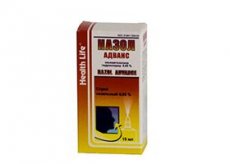Medical expert of the article
New publications
Preparations
Nasol Advance
Last reviewed: 03.07.2025

All iLive content is medically reviewed or fact checked to ensure as much factual accuracy as possible.
We have strict sourcing guidelines and only link to reputable media sites, academic research institutions and, whenever possible, medically peer reviewed studies. Note that the numbers in parentheses ([1], [2], etc.) are clickable links to these studies.
If you feel that any of our content is inaccurate, out-of-date, or otherwise questionable, please select it and press Ctrl + Enter.

Indications Nasol Advance
Nazol Advance can be used to eliminate nasal discharge and relieve symptoms of rhinitis of various origins:
- for nasal discharge that accompanies acute respiratory viral infection or acute respiratory disease;
- for vasomotor or allergic rhinitis;
- for sinusitis or sinusitis.
Nazol Advance can also be used to prepare for diagnostic procedures or operations in the nasal cavity.
Release form
Nazol Advance spray is available in plastic or polyethylene bottles with a built-in sprayer, 15 or 30 ml of 0.05% preparation. The drops look like a transparent solution, with a slight aroma of mint and camphor. Each bottle is packed in a separate cardboard box with instructions.
The active ingredient is oxymetazoline g/h 0.05 g. In addition to it, there are also additional components (benzalkonium chloride, sodium dihydrogen phosphate, sodium hydrogen phosphate, menthol, eucalyptol, camphor, etc.).
Pharmacodynamics
Nazol Advance spray is an external vasoconstrictor. The active ingredient oxymetazoline is an α-adrenergic stimulant that activates adrenergic receptors located in the smooth muscles of the vascular network of the nasal cavity.
Nazol Advance blocks nasal discharge of any origin. The active substance oxymetazoline quickly narrows superficial vessels, reduces signs of swelling of mucous tissues, and facilitates breathing through the nose.
Pharmacokinetics
The effect of oxymetazoline begins to manifest itself immediately after application of the drug to the mucous membranes and intensifies within 10-15 minutes. The duration of the vasoconstrictive effect is up to 10-12 hours.
Systemic absorption of the active component is insignificant. Excretion occurs through the urinary system (more than 2%) and intestines (more than 1%).
Dosing and administration
Nazol Advance is prescribed intranasally:
- adults and children over 12 years of age inject 2-3 doses of 0.05% of the drug up to 2 times a day;
- Children aged 6-12 years inject 1 dose into each nostril up to 2 times a day. The frequency of use of the drug is 1 time in 12 hours.
The duration of the treatment course is up to 3 days.
When injecting, do not tilt your head back or lie down. The bottle should be held vertically during injection.
Use Nasol Advance during pregnancy
The use of Nazol Advance during pregnancy is not recommended. There is no reliable information about the safety of the drug for the course of pregnancy and fetal development.
During lactation, the use of oxymetazoline-based products is contraindicated. This also applies to Nazol Advance spray.
Contraindications
- Hypersensitivity to oxymetazoline, tendency to allergic reactions to other components of Nazol Advance.
- Metabolic disorders (thyroid disease, diabetes).
- Increased intraocular pressure.
- Atrophy of the nasal mucosa.
- Concomitant treatment with MAO inhibitors or other drugs that increase blood pressure.
- Hypertension.
- Pregnancy and lactation period.
- Pheochromocytoma.
- Children under 6 years of age.
Side effects Nasol Advance
With prolonged use of Nazol Advance, the following side effects may develop:
- nagging pain, itching and burning in the nasal cavity;
- redness, thinning and drying of the mucous membrane;
- nasal congestion, drug-induced rhinitis;
- tachycardia, increased blood pressure, heart pain;
- allergy (rash, urticaria, angioedema);
- nausea;
- atrophic changes in the mucous membrane, frequent nosebleeds;
- poor sleep, irritability;
- sneezing;
- headache.
To prevent the occurrence of side effects, it is not recommended to use Nazol Advance for a long time, or to exceed the recommended doses.
Overdose
When using Nazol Advance for more than 4 days in a row, as well as in case of accidental ingestion of the solution, the following signs of overdose may be observed:
- dyspeptic disorders;
- peripheral vascular spasms;
- increased blood pressure;
- convulsions.
Often, an overdose is accompanied by depression of the central nervous system, which manifests itself as fatigue, drowsiness, and the development of a comatose state.
If the drug is swallowed, it is recommended to wash the stomach and take sorbent drugs. If necessary, symptomatic treatment is carried out.
Interactions with other drugs
When combined with other drugs that can constrict blood vessels, increased side effects may occur.
Oxymetazoline impairs the absorption of other nasal drops and prolongs their period of action, and also enhances the effect of MAO inhibitor drugs on the central nervous system.
It is not recommended to conduct long-term treatment with Nazol Advance, as this may provoke the development of atrophic changes in the mucous epithelium. For the same reasons, several vasoconstrictors of local action should not be used simultaneously.
For the treatment of chronic forms of rhinitis, if long-term treatment is required, Nazol Advance is prescribed in combination with other drugs, depending on the cause of the runny nose.
Storage conditions
Nazol Advance is recommended to be stored in dark, dry places, out of reach of children. The optimal temperature for preserving the nasal spray is from +2°C to +25°C.
 [ 38 ]
[ 38 ]
Shelf life
The shelf life of Nazol Advance spray is up to 2 years.
 [ 39 ]
[ 39 ]
Attention!
To simplify the perception of information, this instruction for use of the drug "Nasol Advance" translated and presented in a special form on the basis of the official instructions for medical use of the drug. Before use read the annotation that came directly to medicines.
Description provided for informational purposes and is not a guide to self-healing. The need for this drug, the purpose of the treatment regimen, methods and dose of the drug is determined solely by the attending physician. Self-medication is dangerous for your health.

